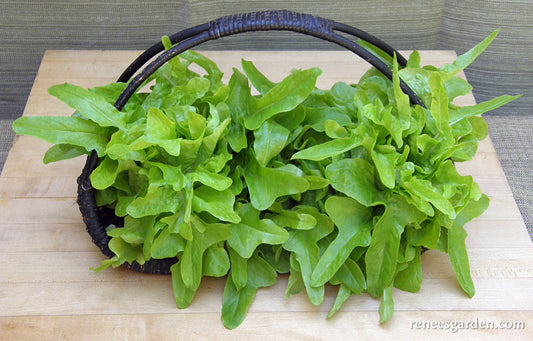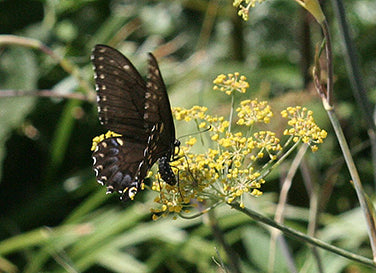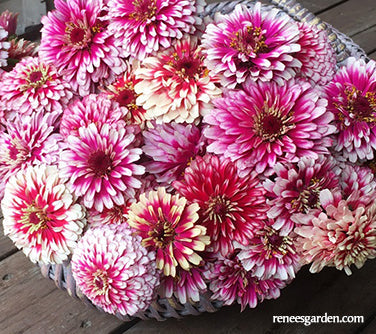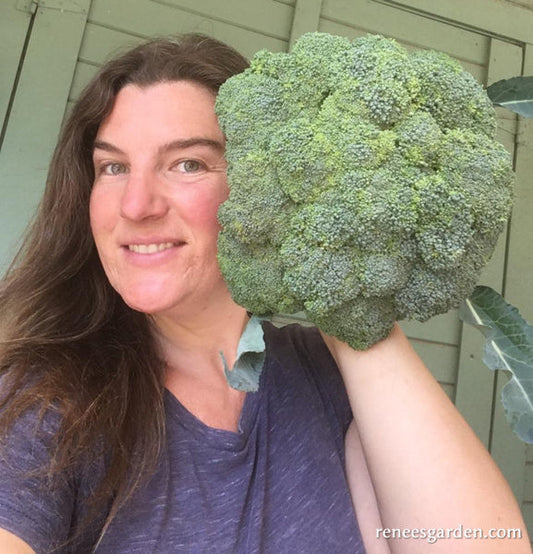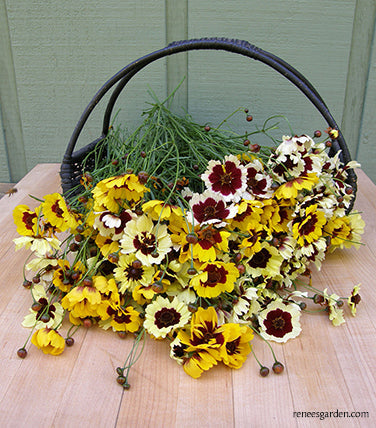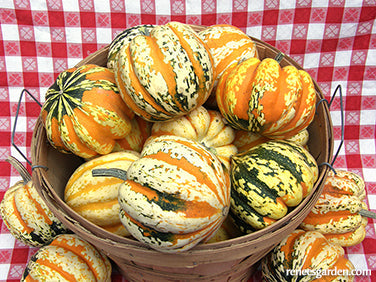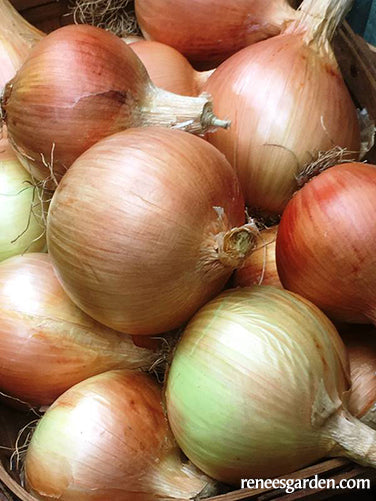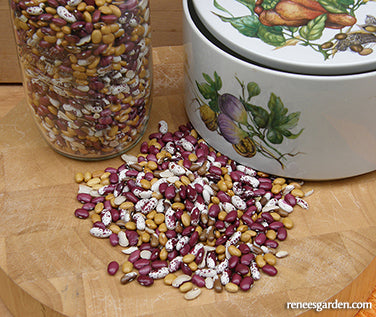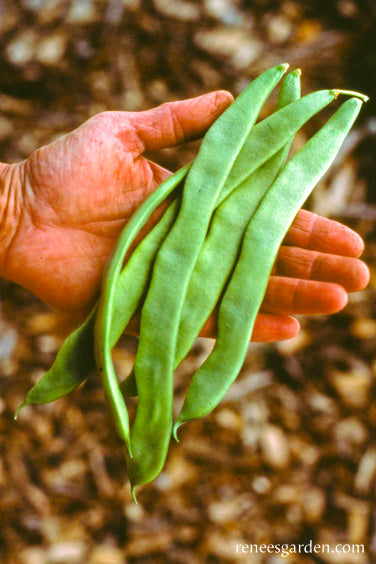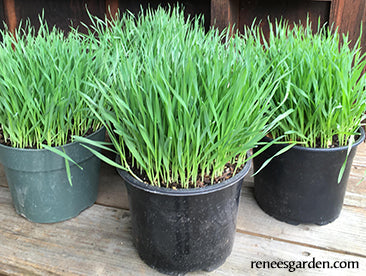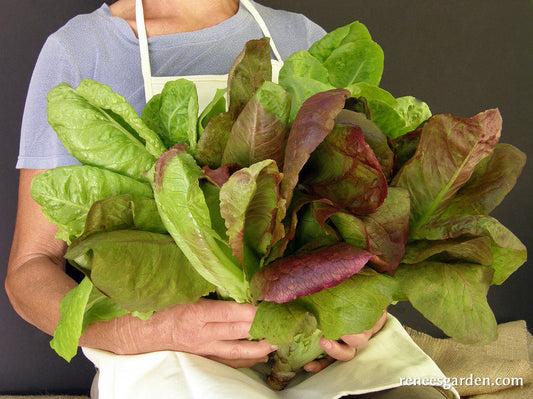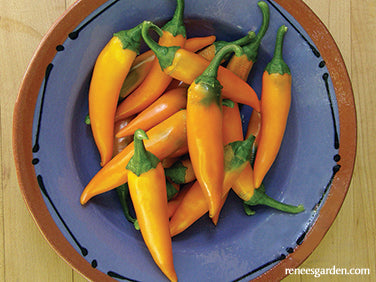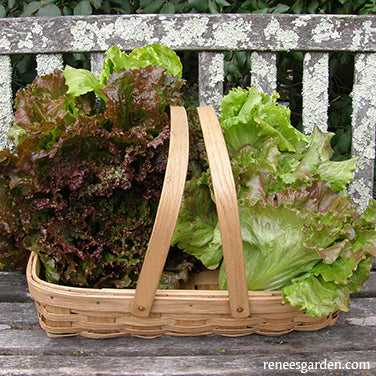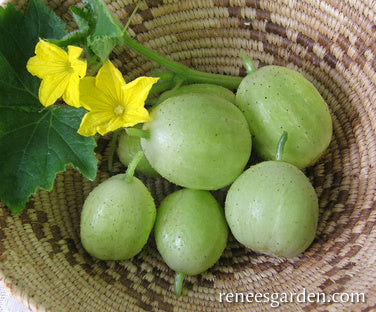All
-
Specialty Eggplants Asian Trio
BEST TO START INDOORS
In early spring, start indoors about 2 months before outdoor night temperatures are reliably in the 50-55°F (10-13°C) range. Sow seeds 1/4 inch deep and 1 inch apart in a container of seed starting mix. Keep moist and warm 80-85°F (27-30°C) and provide a strong light source until ready to plant outside. When seedlings are 2 inches tall, transplant into deeper individual containers. Maintain at 70-75°F (21-24°C). Feed with half-strength fertilizer every 2 weeks until weather is warm enough to gradually acclimate seedlings to outdoor conditions. Transplant 2 feet apart into rich soil in full sun.
GROWING NOTES
Don’t transplant these heat-lovers outdoors until nights stay securely above 55°F (13°C). Prepare soil well with aged manure or compost. Plant only robust seedlings with well-developed roots and mulch well. Fertilize plants regularly throughout the season.
HARVEST AND USE
Pick when fruits have sized up and are firm fleshed and glossy. Harvest Charming babies at 3 to 6 inches, Asian Bride at 7 to 8 inches, and Farmers Long at 9 to 11 inches, or before fruits get dull and seedy. Slice for great sautés or halve lengthwise, brush with oil and grill with your favorite herbs and cheese or Asian-style seasonings.
Regular price $3.69Sale price $3.69Unit price / per -
Heirloom Sweet Peas Mermaid's Dream
ANNUAL CLIMBING VINE
Spring/summer bloom
Frost tolerantEASIEST TO START OUTDOORS
Sweet peas must have well-drained soil, so dig deeply and enrich with aged manure or compost before sowing seeds. Erect a well-anchored trellis, vertical netting or other support for vines before planting. Sow seeds in full sun in cool early spring weather as early as the ground can be worked. In mild winter areas, where the ground does not freeze, seeds can be planted in fall to form strong root systems, then overwinter to bloom strongly in spring. Plant seeds 1 inch deep and 2 to 3 inches apart. When seedlings are 2 inches tall, thin them 4 to 5 inches apart, to allow plants room to mature.
GROWING NOTES
Sweet peas bloom best before the weather gets too hot, so if spring planting, sow as soon as ground can be worked. Where summer heat comes on fast, they’ll appreciate a spot with afternoon shade. Anchor supports well as vines will grow heavy with bloom. Protect seedlings from birds, slugs and snails. Mulch and keep well watered. For longest bloom, pick flowers often and keep faded blossoms cut.Regular price $3.69Sale price $3.69Unit price / per -
Specialty Eggplants Italian Trio
BEST TO START INDOORS
In early spring, start indoors about 2 months before outdoor night temperatures are reliably in the 50 (10°C) range. Sow seeds 1/4 inch deep and 1 inch apart in a container of seed starting mix. Keep moist and warm and provide a strong light source until seedlings are ready to plant outside. When seedlings are 2 inches tall, transplant into deeper individual containers. Maintain at 70 to 75° (21-24°C). Feed with half-strength fertilizer every 2 weeks until weather is warm enough to gradually acclimate seedlings to outdoor conditions. Transplant 2 feet apart into rich soil in full sun.
GROWING NOTES
Don’t transplant these heat-lovers outdoors until night temperatures stay securely above 55° (13°C). Prepare soil well with aged manure or compost. Plant only robust seedlings with well-developed roots and mulch well. Fertilize plants regularly throughout the season.
HARVEST AND USE
Pick when fruits have sized up and are firm fleshed and glossy. Slice 1/2 inch thick, brush with olive oil and broil until tender. Then layer with a rich tomato sauce, fresh herbs and several cheeses to make Eggplant Parmesan. Bake whole in a hot oven, then scoop out flesh and mash with garlic, olive oil, lemon juice and chopped parsley for a savory dip to serve on toasted pita bread.
Regular price $3.69Sale price $3.69Unit price / per -
Pollinator Dahlias Blazing Saddles
PERENNIAL GROWN AS ANNUAL
Frost tender
Summer/Fall BloomBEST TO START EARLY INDOORS
Sow seeds 2 inches apart in containers of seed starting mix, 4 to 6 weeks before last spring frost. Cover 1/2 inch deep, keep moist and warm and provide a strong light source until ready to plant outdoors. When weather is warm and settled, acclimate seedlings gradually to outdoor conditions. Plant 12-14 inches apart in full sun.
TO START DIRECTLY OUTDOORS
Wait until weather is warm and settled and night temperatures are above 50°F (10°C). Sow groups of 2 to 3 seeds 1/2 inch deep and 12-14 inches apart in well-worked, fertile soil in full sun. Cover lightly and keep soil moist but not soggy while awaiting germination. When well-established, thin carefully, leaving one single seedling per group, so plants have room to grow. Keep well-weeded and evenly watered.
GROWING NOTES
Encourage growth and plentiful flowers by feeding plants monthly. Remove faded flowers to prolong bloom. These dahlias will produce underground tubers after their first season of bloom.
In mild winter climates: tubers can overwinter in the ground.
In cold winter climates: dig up the tubers in late fall to replant next spring.Container Growing: Space seedlings 8 in. apart in containers at least 16-18 in. across and 16 in. tall.
Regular price $3.99Sale price $3.99Unit price / per -
Pole Beans Yard Long Noodle King
START SEEDS OUTDOORS
In late spring, once night temperatures stay securely above 55°F (13°C), plant seeds in well-worked, fertile soil in full sun. Erect strong stakes, tripod poles or trellis at planting time to support vines. Plant 1 in. deep & 4 inches apart along a trellis; around tripods or stakes, plant 4 to 6 seeds about 4 in. from each pole, thinning seedlings to 3 best plants per pole.
GROWING NOTES
Yard Long beans are easy to grow as long as you have plenty of sunshine & warm weather. Do not plant too early as cold conditions prevent good germination & growth. If first sowing comes up unevenly, replant right away; new seedlings will catch up quickly. Birds are attracted to young seedlings; watch carefully & protect with netting if necessary. Avoid harvesting beans in wet conditions.
HARVEST AND USE
For the best yields, pick beans frequently, at least every 2 or 3 days. Harvest these astonishingly long, crispy pods when beans are still pencil thin, the pods snap when bent & before the seeds have filled out inside; generally when about 12 to 18 inches long. If the pods get too thick & bulky, they will be fibrous & tough.
Chop the green, skinny pods into 2-3 inch pieces & quickly stirfry or sauté to enjoy their mild, nutty flavor. Try quickly cooking them Asian style with sautéed garlic & ginger, finishing the dish with a little toasted sesame oil & sesame seeds or toasted peanuts. You’ll love them!
Regular price $4.99Sale price $4.99Unit price / per -
Horseradish Roots Big Top
Our easy to grow, premium variety is prized for its size, vigor, wide adaptability and disease resistance. Once planted, each root will produce big sword-shaped green leaves above ground, while the root multiplies and sizes up over the growing season. In late fall, you can dig up plenty to use in making your own spicy horseradish.
You can rely on our Planting and Use Guide (printed copy included with every order) for complete planting, growing, and harvesting information and directions for making homegrown prepared horseradish. Enjoy the wonderful flavor burst of your own horseradish sauce made fresh from the garden!
Each order includes: 2 starter roots, ready to plant.
 See More About Our Horseradish Roots Regular price $18.95Sale price $18.95Unit price / per
See More About Our Horseradish Roots Regular price $18.95Sale price $18.95Unit price / per -
Heirloom Lettuce Baby Oakleaf
START SEEDS OUTDOORS
In cool spring weather, start seeds in full sun. Sow seeds 1/4 nch deep and 1 inch apart in fertile, well-drained soil. When seedlings are several inches tall, thin to a final spacing of 4-5 inches apart. Extra seedlings can easily be transplanted elsewhere.
Container Spacing: Grow 3 plants in an 8 inch pot, or 7 to 8 plants in a 12 to 15 inch diameter container.
GROWING NOTES
Lettuce thrives in cool conditions with consistent moisture. Be sure to thin properly and keep evenly moist for sweet tasting, full heads. For a constant supply, make several sowings a few weeks apart until summer weather turns hot. Plant again in late summer for fall harvest. In hot weather, give lettuce some afternoon shade to extend harvest season and check water daily. Keep soil evenly moist and feed with liquid fertilizer every 2 weeks.
Consider transplanting lettuce seedlings around the edges of a big pot containing a young tomato or pepper plant. The lettuces will be ready to eat just as the bigger plant grows larger and needs the space.
HARVEST AND USE
Savor young thinnings in your first spring salads. Then harvest plants by cutting mature heads when they feel firm and well-filled out. Pull over-mature plants if they begin to elongate (“bolt”) in hot weather, as leaves turn bitter at this stage.
Regular price $3.39Sale price $3.39Unit price / per -
Butterfly Flowers Swallowtail Fennel
PERENNIAL
USDA zone 5-9
TO PLANT DIRECTLY IN THE GARDEN
In spring when danger of hard frost is past, sow seeds 1 inch apart in finely worked, well-drained, fertile soil in full sun. Cover 1/2 inch deep, firm soil and keep seed bed moist. Germination takes 2 to 3 weeks. After seedlings are well established, carefully thin or transplant 1 1/2 feet apart to allow plants room to mature.
TO START EARLY INDOORS
Sow thinly in a container of seed starting mix, 4 to 6 weeks before last expected frost. Keep warm and evenly moist, and provide a good light source. When seedlings are 3 to 4 inches tall, acclimate gradually to outdoor conditions before carefully transplanting as above.
GROWING NOTES
Plant in very well-drained soil. Seedlings grow slowly at first; watch out for them closely as their bronze color makes them easy weed out by accident.
The branching feathery fronds crowned by intricate yellow flowers provide valuable nectar and pollen to a wide range of butterflies, ladybugs, lacewings and other beneficial insects. Colorful blue-green, and copper-bronze foliage is a beautiful contrast with the green foliage and bright colors of summer annuals.
Regular price $3.69Sale price $3.69Unit price / per -
Butterfly Zinnias Summer Pinwheels
ANNUAL
Summer/fall bloom.
Frost tender.EASY TO START DIRECTLY IN THE GARDEN
Sow seeds in well-worked soil in full sun when danger of frost is past and weather is warm and above 50°F (10°C) both day and night. Space seeds 2 to 3 inches apart in rows 12 inches apart, cover about 1/2 inch deep and gently firm soil. Keep soil evenly moist while awaiting germination.
TO START EARLY INDOORS
Four weeks before last frost date, sow seeds 1/2 inch deep and 3 inches apart in a container of seed starting mix. Keep warm and moist and provide a strong light source until seedlings are ready to plant outside when temperatures rise above 50°F (10°C) day and night.
THIN OR TRANSPLANT
Space seedlings 8 to 12 inches apart when large enough to handle so plants have good air circulation and enough elbow room to grow and bloom freely.
GROWING NOTES
Zinnias can grow in ordinary garden soil in full sun. For large, abundant flowers, thin before seedlings get crowded. Adequate spacing and regular, even watering discourages mildew and keeps zinnias productive. Pick just as blossoms begin opening and petals are tight. Cut long stems well back into the plant to keep plants branching low and producing best blooms for summer long bouquets.
Regular price $3.39Sale price $3.39Unit price / per -
Main Crop Broccoli Bravado
BEST TO START INDOORS
Start seeds 4 or 5 weeks before last expected spring frost and again in midsummer for a fall crop. Sow seeds 1 inch apart in a container of seed starting mix, cover 1/2 inch deep and keep evenly moist. Provide a strong light source until seedlings are ready to plant out. When seedlings are 3 to 4 inches tall, gradually acclimate to outdoor conditions, then transplant 12 to 18 inches apart into rich, well-drained soil in full sun.
TO START OUTDOORS
Sow seeds in well-worked, fertile soil in full sun. Plant groups of 2 to 3 seeds 1/2 inch deep and 12 inches apart. Space rows 18 inches apart. Thin to 1 strong seedling per group so plants have room to mature and grow.
GROWING NOTES
Broccoli needs rich, fertile soil and cool growing weather to produce big heads. Prepare soil well and do not let seedlings get too crowded before thinning or transplanting or the heads will be stunted. Keep well watered and weeded. Feed at least monthly with all purpose fertilizer. Use non-toxic B.T. (Bacillus thuringiensis) products to repel caterpillar pests as necessary.
HARVEST AND USE
Harvest the main head before florets open by cutting about halfway down the stalk. This will encourage numerous side shoots to form for extended picking from each plant.
Regular price $3.69Sale price $3.69Unit price / per -
Butterfly Coreopsis Incredible
ANNUAL
Summer/fall bloom
Frost tenderTO START OUTDOORS
Plant after frost danger is over and night temperatures are evenly above 50°F (10°C). Sow seeds in a well-worked seedbed in full sun, 2 in. apart, with rows 12 in. apart. Cover very lightly and gently firm soil. Keep soil evenly moist; germination takes 10-15 days.
TO START EARLY INDOORS
3-4 weeks before last expected frost, sow seeds 1 in. apart in seed starting mix and cover very lightly. Keep warm and moist and provide a strong light source until seedlings are well established. Transplant after gradually acclimating to outdoor conditions.
THIN OR TRANSPLANT
Space seedlings 10 in. apart when large enough to handle.
GROWING NOTES
Coreopsis grows easily in ordinary garden soil in full sun. Be sure to thin seedlings before they get crowded. Incredible grows 2 to 2 1/2 ft. tall and these sturdy, long blooming garden performers and can tolerate hot and dry weather. Pick these decorative flowers often for lovely country style bouquets. Coreopsis are deer resistant and blossoms provide ample food and nectar for butterflies, bees and many other pollinators. After bloom is over, their seed heads provide nutritious food for hungry songbirds.
Regular price $3.99Sale price $3.99Unit price / per -
Winter Squash Festival Acorn
BEST TO START OUTDOORS
Long keeping winter squash needs full sun, rich fertile soil and warm temperatures. Wait to plant until nights are reliably above 50°F (10°C) both day and night. Sow groups of 2 to 3 seeds 2 ft. apart and 1 in. deep in rows 4 ft. apart. Thin to 1 strong seedling per group to give plants ample room to grow. Or make slightly mounded hills 2 to 3 ft. across and 5 ft. apart and plant 4 to 5 seeds in each hill. When seedlings have several sets of leaves, thin to the strongest 3 seedlings per hill.
GROWING NOTES
Protect young seedlings from marauding birds by covering with plastic berry baskets at sowing time, removing before plants get crowded. Thin seedlings properly; you’ll get more squash from well spaced plants.
HARVEST AND USE
Winter squashes need to mature properly, so don’t harvest until vines have died back and squashes’ exterior rinds are fully colored and tough enough to resist piercing with a fingernail. Then cut squashes from vines, leaving a good stem handle. Cure in the sun for about 10 days, before storing in a cool dry place to keep for 2-4 months. To prepare, cut squash in half and bake until tender.
Regular price $4.69Sale price $4.69Unit price / per -
Bulbing Onions Golden Sweet Spanish
FOR BEST RESULTS
Sow seeds in early spring as soon as soil can be worked; in mild winter areas, seeds can also be sown in fall to overwinter for a head start in spring growth. They have a broad planting range, being on the cusp of intermediate and long day onions.
To Start Early Indoors: Sow 1 in. apart in a container of seed starting mix and cover 1/4 in. deep. Provide a strong light source until seedlings are 2 to 3 in. tall. Transplant 4 in. apart, burying crowns 1 in. deep.
To Start Outdoors: Sow seeds in well-worked, fertile soil in full sun. Space 1 in. apart in rows 8 in. apart. Cover 1/4 in. deep, firm soil well over seeds, and keep evenly moist. Thin seedlings gradually to a final 4 in. spacing, using the tasty thinnings.
GROWING NOTES
Before planting, thoroughly work compost or well-aged manure and an organic, all-purpose fertilizer into the soil. Keep onions well-weeded and mulch plants once soil warms up to conserve moisture. Feed onions lightly with an all-purpose fertilizer several times during the growing season. The “bite” or spiciness of onions depends on your soil type and composition.
HARVEST AND USE
Harvest midsummer when bulbs are sized up and about half the onion tops are bent over. Stop watering and bend the rest of the tops down. After another 7 to 10 days or when tops are dry, pull the bulbs. If possible, let the onions dry in the sun for 5 to 7 days. Store bulbs in a cool, airy place.
Regular price $3.39Sale price $3.39Unit price / per -
Heirloom Dry Beans Soup Mix Blend
START SEEDS OUTDOORS
Don’t plant too early; cold conditions prevent good bean germination. In late spring, when nights are securely above 55°F (13°C), sow seeds in well worked, fertile soil in full sun. Poke seeds in 1 inch deep and 4 inches apart in rows 1 1/2 to 2 feet apart.
GROWING NOTES
If first sowing comes up unevenly, replant right away; new seedlings catch up quickly. Bean seedlings are tempting treats to birds; watch carefully and protect with netting if necessary.
HARVEST AND USE
Check out our harvesting video!
When the beans are hard and smooth inside dry and leathery pods, harvest the whole crop at once, or, if frost or excessive rain threatens, pull entire plants and finish drying in a sheltered spot. Shell out the completely dry beans by hand or put whole pods in a pillowcase and whack it on the ground to “spill the beans” from pods. Put cleaned, shelled beans in freezer for 3 to 4 days to eliminate any insects, then store in glass jars in a cool dry place.
Note: freshly grown dry beans will cook faster than store bought ones. Soak overnight first, then cook up with a bay leaf, garlic and savory herbs.
Regular price $4.39Sale price $4.39Unit price / per -
Early Pole Beans Spanish Musica
START SEEDS OUTDOORS
In spring once weather is warm and night temperatures stay securely above 55°F (13°C), plant seeds in well-worked, fertile soil in full sun. Erect strong stakes, tripod poles, or trellis at planting time to support vines. Plant seeds 1 inch deep and 4 inches apart along a trellis, or if planting around tripods or stakes, plant 4 to 6 seeds 4 inches from each pole, thinning seedlings to 3 best plants.
GROWING NOTES
Tender crispy beans are an easy reliable crop to grow, but do not plant seeds too early as cold conditions prevent good germination. If first sowing comes up unevenly, replant right away; new seedlings will catch up quickly. Birds are often attracted to young bean seedlings, so watch carefully and protect with netting or floating row covers if necessary. Avoid cultivating plants or picking pods when plants are wet.
HARVEST AND USE
Musica’s strong vines are heavy bearers, so plan to harvest often. The more you pick, the more plants will produce. Harvest when beans are broad and 7 to 9 inches long. Slice in pieces and cook just until tender to enjoy their fine flavor and meaty texture. Serve hot, or cool and toss with herbed vinaigrette for a delicious green bean salad.
Regular price $4.99Sale price $4.99Unit price / per -
Bonus Pack Wheatgrass For Juicing
GROW IN POTS INDOORS OR OUT
Wheatgrass can be grown indoors year round; it prefers temperatures between 65-75° F (18 to 24° C) or or grow outdoors in pots after spring weather is warm, and nights are over 50° F (10° C). This generous packet provides more than enough seed for 6 separate sowings in 6 inch pots. Disinfect pots before use by soaking in a solution of 1 part bleach and 9 parts water for 30 minutes and air dry.
GROWING AND HARVESTING
Fill a 6 inch in diameter or larger pot (that has a drainage hole) with moistened organic planting mix. Sprinkle seeds evenly over the surface about 1/4 inch apart. Cover 1/2 inch deep with planting mix. Water gently but thoroughly. Check often; keep moist but not soggy. Keep pot in bright light or full sun. Harvest by cutting with scissors when wheatgrass is 4 to 6 inches tall, about 10 to 14 days after sowing. Wheatgrass grows back for a second harvest, but the second harvest will be weaker.
For a constant supply, sow more seeds in a new pot weekly, always using fresh soil mix. Harvest and use pots of grass in succession. After the second harvest in each pot, discard and start again with more seeds and fresh soil mix. (Each sowing uses up the available nutrients in soil mix so discard and use fresh mix) A 6 inch pot of wheatgrass will yield about 5 to 6 ounces of fresh juice.
HOW TO USE
Wheatgrass must be consumed as juice. If you want to juice regularly, we recommend buying a specialized wheatgrass juicer, which makes juicing easy and produces a superior product. A lesser, but passable alternative is to put a handful of cut wheatgrass in a blender with a cup of water, blend until liquefied and carefully strain out pulp from the juice. Drink immediately or keep refrigerated and drink soon: juice loses quality and nutrient value quickly. Drink 1 ounce of wheatgrass juice per day for general health.
Regular price $6.99Sale price $6.99Unit price / per -
Green & Red Romaines Renee's Caesar Duo
START SEEDS OUTDOORS
In cool early spring weather, start seeds in finely worked soil in full sun. Sow 1/4 inch deep and 1 inch apart in rows 6 to 8 inches apart and cover lightly. Tend carefully and keep evenly moist. Gradually thin seedlings out, allowing remaining plants to stand 10 to 12 inches apart so heads have room to mature. For a constant supply, make several sowings a few weeks apart until summer weather turns hot. Plant again in late summer for fall harvest.
GROWING NOTES
Lettuce thrives in cool conditions with consistent moisture. Weed, water and thin carefully for best quality heads. If birds are attracted to the young seedlings, cover them with floating row covers or netting.
HARVEST AND USE
Savor young thinnings in your first spring salads. Then harvest plants by cutting mature heads when they feel firm and well-filled out. Pull and discard or compost over-mature plants if they begin to elongate (“bolt”) in hot weather as they are bitter at this stage. These crispy colorful romaines are perfect for centerpiece Caesar salads that rival the finest restaurant. Use top quality ingredients to make dressing, or you can find my favorite recipe on our website: reneesgarden.com/recipes
Regular price $3.39Sale price $3.39Unit price / per -
Heirloom Chiles Bulgarian Carrot
STARTING SEEDLINGS
In early spring, start indoors about 2 months before night temperatures stay reliably 50-55°F (10-13°C). Sow seeds 1/4 inch deep and 1 inch apart in a container of seed starting mix. Keep moist but not soggy, and very warm 80-85°F (27-30°C). Provide a strong light source until seedlings are ready to plant outside. When seedlings are 2 inches tall, transplant into deeper individual containers. Maintain at 70-75°F (21-24°C).
Feed with half strength fertilizer every week until weather is warm enough to gradually acclimate seedlings to outdoor conditions. Transplant 1 1/2 feet apart into rich soil in full sun.
GROWING NOTES
Chiles need warm conditions; don’t transplant outdoors until night temperatures stay securely above 55°F (13°C). Prepare soil well with aged manure or compost. Plant only robust seedlings with well-developed roots. Mulch plants to maintain even soil moisture. Keep well weeded, watered and fertilized.
HARVEST AND USE
Harvest when chiles have colored up to deep orange with a high gloss. Use these hot and fruity flavored little chiles for delicious salsas, hot sauces, spicy pickled peppers or in any recipe using hot chiles. Carrot chiles have thick flesh and do not dry well, so freeze in heavy Ziploc bags if preserving for future use.
Regular price $3.69Sale price $3.69Unit price / per -
Woven Oak Harvesting Baskets
For over 140 years, this small family business near Chesapeake Bay, MD has been making quality traditional split-oak baskets by hand for hard-working gardeners and market farmers. Part of our national craft heritage, their basket making process is documented in the Smithsonian Institute.
Baskets Are Available In 2 Sizes:
Square Basket: 13x13x4 in. drop-handled basket is perfect for herbs, flowers, and salads. Originally designed in the 19th century as a pie man’s basket!
Rectangular Basket: the perfect workhorse: larger 18x12x4 in. size is big enough so only one trip from garden to kitchen is necessary.
Please note: Baskets ship directly from the vendor. Allow 2 weeks for delivery. Sorry, we cannot ship to Alaska, Hawaii or Canada. Please provide a street address for delivery; we cannot ship baskets to a PO Box.
Regular price From $110.00Sale price From $110.00Unit price / per -
The Perfect Tomato Slicing Knife
This unique knife is the best for effortlessly slicing ripe tomatoes without squashing their juicy flesh. The handy little ever sharp kitchen tool has a comfortable, molded handle and a perfectly angled, serrated blade that is ideal for cleanly and quickly cutting up juicy fruits and thin-skinned vegetables and every kind of precise slicing task in the kitchen.Besides making short work of our big tomato harvests, we use it for easy paper-thin slices of onions, lettuce, cucumbers, peppers, radishes and pickles and all kinds of fruits like apples, pears, mangoes, peaches oranges and lemons and for perfect thin hard-boiled egg slices.
Regular price $14.95Sale price $14.95Unit price / per -
Peel, Pare & Slice Tool Set
A boxed set of 3 well-made precision tools you can rely on for fast and efficient kitchen work. American-made of surgical quality, high carbon stainless steel with a lifetime guarantee. Dishwasher safe!
The Paring Knife is the perfect size for everyday cutting tasks, and feels right and balanced in your hand. Hand sharpened, with a hollow ground blade for maximum edge retention, this “go to” knife will be the most used tool in your kitchen.
The Vegetable Peeler features a dual-edged blade whose swiveling design peels effortlessly both away or towards you. Makes quick work of peeling carrots or celery for snacks & lunch boxes, or making perfect chocolate curls! Serves right or left-handed cooks.
The Tomato Slicer, with its dual-edged stainless steel serrated blade makes it easy to cut beautiful even slices of soft fruits like tomatoes or ripe peaches without squashing their tender flesh and thin skins. Makes precise slices of hard-boiled eggs and avocados too.Regular price $32.95Sale price $32.95Unit price / per -
The 2-in-1 Kitchen Compost Pail
At last, an attractive and really functional kitchen compost pail!
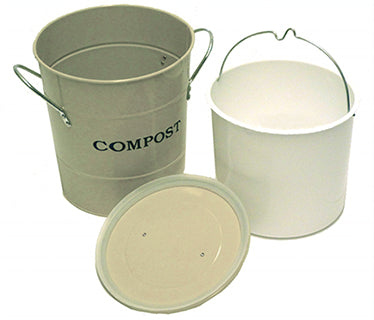 Regular price $32.95Sale price $32.95Unit price / per
Regular price $32.95Sale price $32.95Unit price / per -
FloraLife Liquid Flower Food
Extends Cut Flower Life
We think you’ll agree that one of gardening’s great pleasures is having abundant fresh flowers for long-lasting indoor bouquets.
Your cut flowers are still alive and breathing and need the right care for longest vase life. In the trial garden, we keep our bottle of FloraLife Liquid Flower Food next to the sink and add it to vase water every time we bring flowers indoors, so we recommend it heartily!
Originally formulated for the florist industry, FloraLife Flower Food core ingredients contain an optimum blend of sugar, light acids and balancers. When added to vase water, it provides nutrition to your flowers, keeps vase water clean by inhibiting bacteria, and sustains hydration to really keep flowers looking fresh longer.
Add 2 teaspoons per 1 quart (4 cups) of water. Each 8 oz. bottle makes 100 cups or 25 quarts of vase solution.Regular price $14.95Sale price $14.95Unit price / per -
Heirloom Cucumbers Lemon Cucumbers
START SEEDS OUTDOORS
Plant heat-loving cucumbers in full sun only when weather is warm and settled and night temps stay above 50°F (10°C), first amending soil well with aged manure or compost. Sow groups of 2 to 3 seeds, 1 inch deep and 18 inches apart. When the baby seedlings are 2 inches tall, thin out extras, leaving one strong seedling per group. After thinning, provide a 3 to 5 foot strong vertical support or tomato cage around each seedling and train the vines up the supports as they grow. Growing vigorous, heavy-bearing cucumber vines up supports makes it easier to harvest the cucumbers, saves garden space, and helps prevent disease.
GROWING NOTES
Protect seedlings from marauding birds with plastic berry baskets, removing before plants get crowded. Shallow-rooted cucumbers need adequate and consistent moisture to produce sweet tasting, nicely formed cucumbers. Avoid overly wet or dry periods for good quality fruits.
HARVEST AND USE
For best quality, sweet tasting fruits, be sure to pick young lemon cucumbers when they are still pale green with just a hint of lemon color on their skins. Bright yellow fruits are pretty but overmature and they will have tough skins and seeds. Enjoy the freshly picked, lemon-shaped cucumbers still warm from the sun as snacks and in salads. These old-fashioned cucumbers also make fine tasting pickles, both sweet and dill.
Regular price $2.99Sale price $2.99Unit price / per

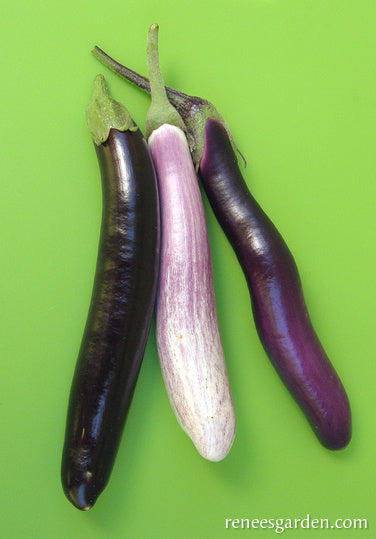

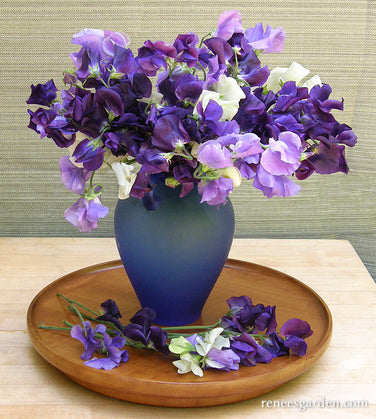



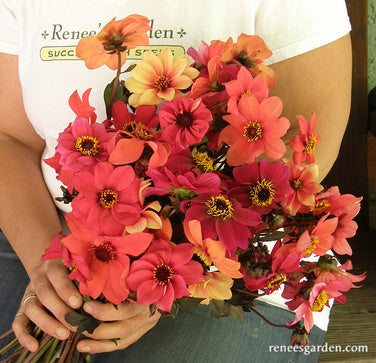



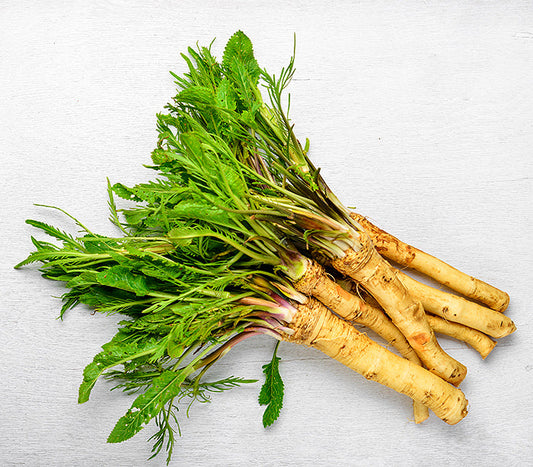
 See More About Our Horseradish Roots
See More About Our Horseradish Roots
